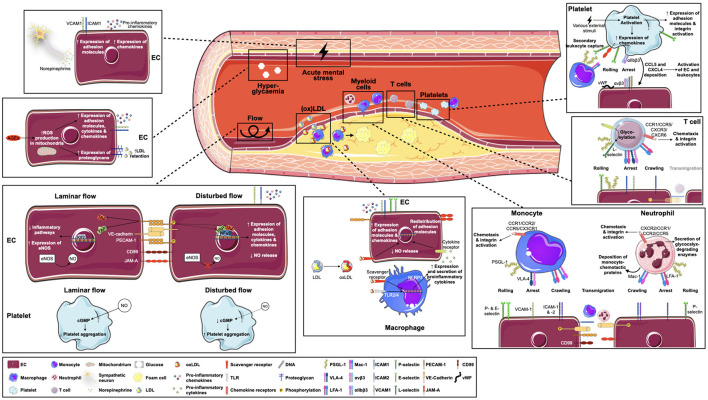Figure 1.
Key factors in atherosclerosis-specific leukocyte recruitment. Leukocyte recruitment into atherosclerotic plaques is multifaceted and involves several players. Endothelial activation through disturbed flow patterns and oxidized lipoproteins, but possibly also via hyperglycemia or local sympathetic innervation, forms the basis for subsequent leukocyte-endothelial interactions. Of note, specific leukocyte populations respond differently to atherogenic triggers and use unique molecules and receptors to achieve leukocyte rolling, arrest, crawling and transmigration. Additionally, platelets strongly contribute to leukocyte recruitment by secondary leukocyte capture and activation of endothelial cells and leukocytes. AEG = advanced glycosylation end products; CCL, C-C motif chemokine ligand; CCR, C-C motif chemokine receptor; CD99, cluster of differentiation 99; cGMP, cyclic guanosine monophosphate; CXCL, C-X-C motif chemokine ligand; CX(3)CR, C-X(3)-C motif chemokine receptor; EC, endothelial cell; eNOS, endothelial nitric oxide synthase; E-selectin, endothelial selectin; ICAM-1/2, intracellular adhesion molecule 1/2; Klf2, Krüppel-like factor 2; NLRP3, NOD-, LRR- and pyrin domain-containing protein 3; L-selectin, leukocyte selectin; Mac-1, macrophage receptor 1; NO, nitric oxide; (ox)LDL, (oxidized) lipoprotein; PECAM-1, platelet endothelial cell adhesion molecule 1; P-selectin, platelet selectin; PSGL-1, P-selectin glycoprotein ligand 1; ROS, reactive oxygen species; TLR, toll-like receptor; VCAM-1, vascular adhesion molecule 1; VE-cadherin, vascular endothelial cadherin; VLA-4, very late antigen 4; vWF, von Willebrand factor, YAP, yes-associated protein.

